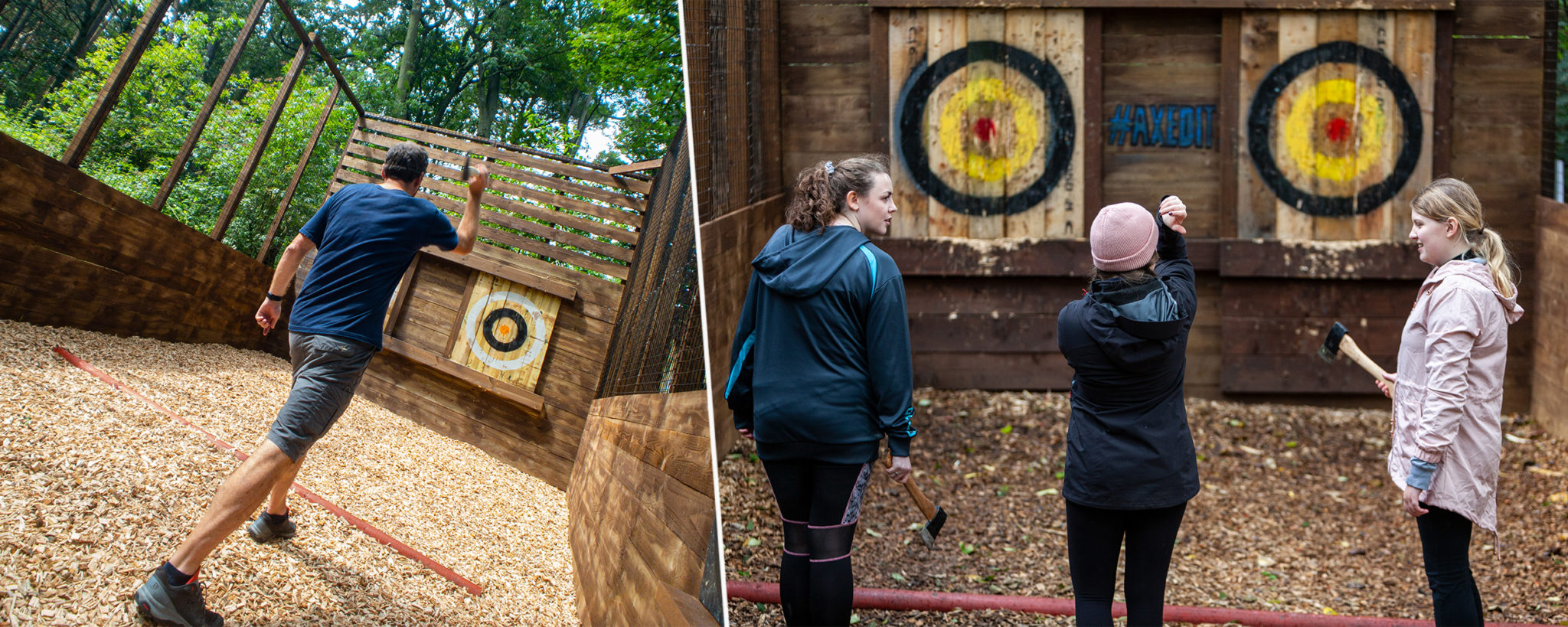Study the Axe Throwing Denver Scene: What You Need to Know
Study the Axe Throwing Denver Scene: What You Need to Know
Blog Article
The Enjoyable of Axe Throwing: How This Sport Incorporates Ability and Adrenaline for a Great Time
Axe throwing has actually become a mesmerizing sporting activity that masterfully intertwines the requirement for accurate ability with the rush of adrenaline, offering individuals a unique and appealing experience. The act of tossing an axe towards a target requires focus and strategy, simultaneously cultivating an environment of camaraderie and friendly competition. This appealing mix of psychological focus and physical effort has made axe throwing a prominent choice for those looking for both recreation and a feeling of success. To genuinely value the deepness and allure of this activity, one need to consider its origins, the needed devices, and the fundamental strategies that make sure both safety and satisfaction.
The Origins of Axe Throwing
Axe tossing, a recreational activity that has acquired significant popularity in recent years, traces its origins back to old times. The earliest documents of axe use in competitive contexts are discovered among the Celts and Vikings, that tossed axes for sport as well as in fight training.
Middle ages European warriors, especially during the Middle Ages, practiced axe tossing as component of their martial training. The Francisca, a kind of throwing axe utilized by the Franks, became famous for its harmful precision. This standard tool was developed to be thrown at enemy shields and armor, showcasing its dual utility in both sporting activity and fight.
In more recent background, axe throwing saw a resurgence in the logging camps of North America in the 19th and 20th centuries. Lumberjacks would take part in friendly competitors, checking their precision and strength by targeting at wood targets. This development from a survival ability to a recreational task has led the way for its contemporary resurgence, with devoted locations and leagues currently commemorating the sport internationally.
Equipment You Required
Recognizing the abundant history of axe throwing improves the gratitude of the sporting activity's modern-day model. Central to this thrilling activity is the equipment, which is vital for both safety and security and performance. The main tool is, certainly, the axe. For affordable and entertainment axe throwing, one of the most generally made use of type is the hatchet, generally evaluating in between 1.25 to 2 pounds with a take care of size of about 16 inches. The axe ought to have a sharp, well-kept blade and a take care of made from resilient wood or composite material, guaranteeing a good grasp and balance.
Equally crucial is the target. Regulation targets are built from timber, with softwood selections like want or cottonwood being favored for their ability to hold the axe and take in. The target is generally separated into five concentric circles, each with a particular point value, to facilitate rating.
Security gear, though frequently forgotten, is important. Safety gloves can improve hold and prevent sores, while closed-toed footwear are a must to shield feet from gone down axes (denver axe throwing). A well-lit, roomy tossing location, full with safety and security barriers, makes sure a controlled setting where participants can focus on developing their abilities.
Basic Techniques Described
Grasping the basic techniques of axe throwing is vital for both safety and efficiency. The dominant hand must be positioned directly listed below the axe head, while the non-dominant hand supports the end of the handle.
Following, focus on the stance. Stand with your feet shoulder-width apart, guaranteeing your body is stabilized. Your dominant foot should be slightly forward, lining up with your target. This positioning help in maintaining stability and directing power accurately towards the target.

Security First
Ensuring safety in axe throwing is critical to developing an injury-free and enjoyable experience. Precaution start with the venue format. A well-designed axe throwing facility attributes clear demarcations between throwing lanes, sturdy backgrounds to catch stray axes, and non-slip floor covering to stop crashes. In addition, ample illumination is important to help participants maintain aesthetic precision and spatial recognition.
Benefits of Axe Throwing
Axe tossing offers a myriad of benefits that prolong past basic recreation. Physically, it offers a full-body workout, involving muscles in the arms, shoulders, back, and core. The recurring movement of tossing the axe also boosts hand-eye control this website and great motor abilities. For those wanting to boost their total fitness, axe throwing can act as a vibrant and appealing type of exercise.
Mentally, axe tossing calls for technique, precision, and focus, making it an exceptional means to hone cognitive skills. The focus required to strike the target can act as a kind of mindfulness, permitting participants to clear their minds and minimize tension. This psychological interaction can be specifically valuable in helping individuals establish much better analytic abilities and mental durability.
Socially, axe throwing is often enjoyed in group settings, promoting team-building and camaraderie. Whether as component of a business occasion or an informal getaway with close friends, the sporting activity motivates interaction and collaboration. Additionally, the common experience of finding out and boosting with each other can strengthen relationships and develop enduring memories.
Final Thought

The earliest records of axe usage in competitive contexts are discovered among the Celts and Vikings, who threw axes for sporting activity as well as in combat training. Launch the axe when your hands are approximately at eye degree, allowing the axe's all-natural turning to assist it in the direction of the target.
A properly designed axe throwing center attributes clear separations between throwing lanes, strong backdrops to catch stray axes, and non-slip flooring to stop crashes. Individuals have to be instructed on the appropriate way to deal with and throw the axe, emphasizing regulated, deliberate activities over strong throws.
In recap, axe throwing stands out as a sport that masterfully incorporates skill, precision, and adrenaline.
Report this page